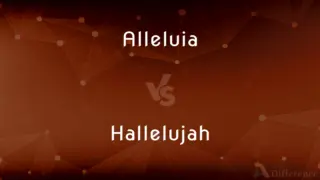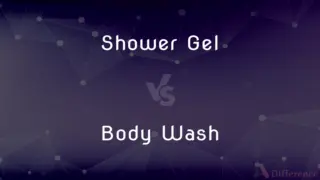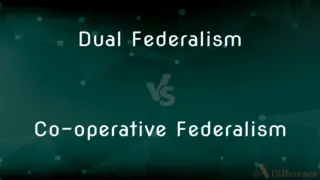Electricity vs. Magnetism — What's the Difference?
By Maham Liaqat & Urooj Arif — Updated on April 1, 2024
Electricity involves the movement and interaction of electrons, producing energy and power, while magnetism is a force arising from the motion of electric charges, causing attraction or repulsion between objects.

Difference Between Electricity and Magnetism
Table of Contents
ADVERTISEMENT
Key Differences
Electricity is a form of energy resulting from the existence and flow of electric charge. It powers our world, from lighting our homes to running complex electronic devices. The flow of electrons through a conductor, such as a wire, creates electrical current, a primary component of electricity. In contrast, magnetism is a physical phenomenon produced by the motion of electric charges, resulting in attractive or repulsive forces between objects. While electricity can exist without magnetism when charges are static, magnetism always involves the movement of charges.
The relationship between electricity and magnetism is intricate. Electrical currents generate magnetic fields, a fundamental principle behind electromagnets, where coiling a wire around a core and passing an electric current through the wire produces a magnetic field. Conversely, changing magnetic fields can induce electrical currents in conductors, a principle utilized in generators and transformers. This interdependence is the foundation of electromagnetism, a key aspect of classical physics.
While both phenomena involve the fundamental forces of charged particles, their applications differ significantly. Electricity is primarily harnessed for energy and power, utilized in everything from household appliances to industrial machinery. Magnetism, on the other hand, is exploited in various applications such as magnetic storage devices, electric motors, and magnetic resonance imaging (MRI) machines. The distinction lies in electricity's role as a versatile energy source, whereas magnetism is crucial in fields requiring specific directional forces and information storage.
The study of electricity and magnetism has led to significant technological advancements. The understanding of electric currents and their relationship with magnetic fields has enabled the development of countless devices and technologies, from the electric light bulb to modern computers and telecommunications. Magnetism's unique properties have been instrumental in developing data storage solutions, including hard drives and magnetic tape, leveraging the ability of magnetic materials to retain patterns of magnetization.
Despite their differences, the synergy between electricity and magnetism underpins many modern technologies. The generation of electrical power in most power plants uses turbines moved by various means (such as steam, water, or wind) to rotate a magnet inside a coil of wire, inducing an electric current. Similarly, electric motors convert electrical energy into mechanical motion through the interaction of magnetic fields and current-carrying conductors.
ADVERTISEMENT
Comparison Chart
Definition
The presence and flow of electric charge
The force exerted by magnets when they attract or repel each other
Fundamental Cause
Movement of electrons
Movement of electric charges creating magnetic fields
Primary Applications
Power generation, lighting, electronics
Data storage, electric motors, magnetic resonance imaging (MRI)
Relationship
Can exist without magnetism (in static charges)
Always involves electricity (moving charges)
Key Phenomena
Electrical current, voltage, resistance
Magnetic fields, attraction, repulsion
Compare with Definitions
Electricity
Measured in amperes, volts, and watts.
Household electricity typically uses 120 volts in North America.
Magnetism
Arises from the movement of electric charges.
Spinning electrons in atoms create magnetic fields.
Electricity
A form of energy resulting from the flow of electrons.
Electricity powers our homes and devices.
Magnetism
A force that causes attraction or repulsion between objects.
Magnetism allows a compass needle to point north.
Electricity
Can be generated from various sources.
Wind turbines generate electricity by converting kinetic energy from the wind.
Magnetism
Utilized in data storage and retrieval.
Hard drives store data using magnetism.
Electricity
Essential for modern life, powering technology and infrastructure.
Electricity is crucial for operating hospitals and emergency services.
Magnetism
Can be manipulated to create electromagnets.
An electromagnet can lift heavy iron objects when powered.
Electricity
Powers electrical devices through the movement of charge.
The lamp lights up using electricity.
Magnetism
Integral to the function of electric motors and generators.
Electric motors convert electrical energy into motion using magnetism.
Electricity
Electricity is the set of physical phenomena associated with the presence and motion of matter that has a property of electric charge. Electricity is related to magnetism, both being part of the phenomenon of electromagnetism, as described by Maxwell's equations.
Magnetism
Magnetism is a class of physical attributes that are mediated by magnetic fields. Electric currents and the magnetic moments of elementary particles give rise to a magnetic field, which acts on other currents and magnetic moments.
Electricity
The physical phenomena arising from the behavior of electrons and protons that is caused by the attraction of particles with opposite charges and the repulsion of particles with the same charge.
Magnetism
The class of phenomena exhibited by a magnetic field.
Electricity
The physical science of such phenomena.
Magnetism
The study of magnets and their effects.
Electricity
Electric current used or regarded as a source of power.
Magnetism
The force exerted by a magnetic field.
Electricity
Intense, contagious emotional excitement.
Magnetism
Unusual power to attract, fascinate, or influence
The magnetism of money.
Electricity
Originally, a property of amber and certain other nonconducting substances to attract lightweight material when rubbed, or the cause of this property; now understood to be a phenomenon caused by the distribution and movement of charged subatomic particles and their interaction with the electromagnetic field.
Magnetism
Animal magnetism.
Electricity
(physics) The study of electrical phenomena; the branch of science dealing with such phenomena.
Magnetism
(physics) The property of being magnetic.
Electricity
A feeling of excitement; a thrill.
Opening night for the new production had an electricity unlike other openings.
Magnetism
(physics) The science which treats of magnetic phenomena.
Electricity
Electric power/energy as used in homes etc., supplied by power stations or generators.
Magnetism
Power of attraction; power to excite the feelings and to gain the affections.
Electricity
A property of certain of the fundamental particles of which matter is composed, called also electric charge, and being of two types, designated positive and negative; the property of electric charge on a particle or physical body creates a force field which affects other particles or bodies possessing electric charge; positive charges create a repulsive force between them, and negative charges also create a repulsive force. A positively charged body and a negatively charged body will create an attractive force between them. The unit of electrical charge is the coulomb, and the intensity of the force field at any point is measured in volts.
Magnetism
Animal magnetism.
Electricity
Any of several phenomena associated with the accumulation or movement of electrically charged particles within material bodies, classified as static electricity and electric current. Static electricity is often observed in everyday life, when it causes certain materials to cling together; when sufficient static charge is accumulated, an electric current may pass through the air between two charged bodies, and is observed as a visible spark; when the spark passes from a human body to another object it may be felt as a mild to strong painful sensation. Electricity in the form of electric current is put to many practical uses in electrical and electronic devices. Lightning is also known to be a form of electric current passing between clouds and the ground, or between two clouds. Electric currents may produce heat, light, concussion, and often chemical changes when passed between objects or through any imperfectly conducting substance or space. Accumulation of electrical charge or generation of a voltage differnce between two parts of a complex object may be caused by any of a variety of disturbances of molecular equilibrium, whether from a chemical, physical, or mechanical, cause. Electric current in metals and most other solid coductors is carried by the movement of electrons from one part of the metal to another. In ionic solutions and in semiconductors, other types of movement of charged particles may be responsible for the observed electrical current.
Magnetism
The property, quality, or state, of being magnetic; the manifestation of the force in nature which is seen in a magnet. At one time it was believed to be separate from the electrical force, but it is now known to be intimately associated with electricity, as part of the phenomenon of electromagnetism.
Electricity
The science which studies the phenomena and laws of electricity; electrical science.
Magnetism
The science which treats of magnetic phenomena.
Electricity
Fig.: excitement, anticipation, or emotional tension, usually caused by the occurrence or expectation of something unusual or important.
Magnetism
Power of attraction; power to excite the feelings and to gain the affections.
Electricity
A physical phenomenon associated with stationary or moving electrons and protons
Magnetism
Attraction for iron; associated with electric currents as well as magnets; characterized by fields of force
Electricity
Energy made available by the flow of electric charge through a conductor;
They built a car that runs on electricity
Magnetism
The branch of science that studies magnetism
Electricity
Keen and shared excitement;
The stage crackled with electricity whenever she was on it
Common Curiosities
How do electricity and magnetism interact in everyday devices?
They interact in devices like electric motors, which convert electrical energy into mechanical motion using magnetic fields.
What is the key difference between electricity and magnetism?
Electricity is the energy from moving electric charges, while magnetism is the force from moving charges that creates attraction or repulsion.
What are the units used to measure electricity and magnetism?
Electricity is measured in amperes (current), volts (voltage), and watts (power), while magnetic field strength is measured in teslas or gauss.
Can magnetism be used to store information?
Yes, in devices like hard drives, information is stored in the form of magnetic patterns.
How is electricity generated through magnetism?
Through electromagnetic induction, where a changing magnetic field within a coil of wire induces an electric current.
What are permanent magnets and how do they differ from electromagnets?
Permanent magnets maintain a constant magnetic field without electricity, while electromagnets require an electric current to generate a magnetic field.
Can you have magnetism without electricity?
No, magnetism inherently involves the movement of electric charges, thus requiring electricity.
What role does magnetism play in medical imaging?
Magnetism is crucial in MRI machines, where strong magnetic fields are used to produce detailed images of the body.
What are the environmental impacts of generating electricity?
Depending on the source, generating electricity can have various environmental impacts, including pollution from fossil fuels and habitat disruption from dams.
What makes a material magnetic?
Materials become magnetic when the spins of their electrons align in a unified direction, creating a magnetic field.
How has the study of electricity and magnetism impacted technology?
It has led to the development of essential technologies, including power generation systems, electric motors, and electronic devices.
Is lightning a form of electricity or magnetism?
Lightning is a form of electricity, caused by the discharge of static electric charge in the atmosphere.
Can the Earth's magnetism affect electrical systems?
Yes, geomagnetic storms caused by solar activity can disrupt electrical power grids and communication systems.
How do solar panels convert sunlight into electricity?
Solar panels use photovoltaic cells to convert sunlight directly into electricity through the photoelectric effect.
Why is alternating current (AC) used in power transmission?
AC is used for power transmission due to its ability to be easily transformed to higher or lower voltages, reducing energy loss over long distances.
Share Your Discovery

Previous Comparison
Scuba vs. Scuta
Next Comparison
Pencilled vs. PenciledAuthor Spotlight
Written by
Maham LiaqatCo-written by
Urooj ArifUrooj is a skilled content writer at Ask Difference, known for her exceptional ability to simplify complex topics into engaging and informative content. With a passion for research and a flair for clear, concise writing, she consistently delivers articles that resonate with our diverse audience.














































